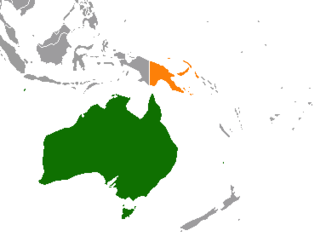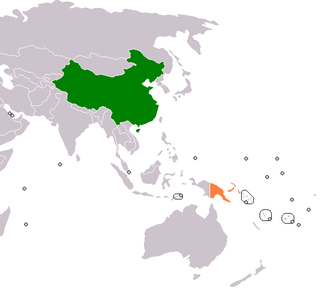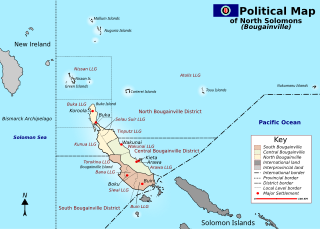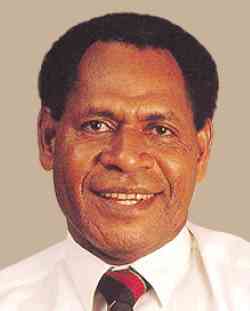Related Research Articles

Papua New Guinea, officially the Independent State of Papua New Guinea, is a country in Oceania that comprises the eastern half of the island of New Guinea and its offshore islands in Melanesia. It shares its only land border with Indonesia to the west and its other close neighbors are Australia to the south and the Solomon Islands to the east. Its capital, located on its southern coast, is Port Moresby. The country is the world's third largest island country, with an area of 462,840 km2 (178,700 sq mi).

The prehistory of Papua New Guinea can be traced to about 50,000–60,000 years ago, when people first migrated towards the Australian continent. The written history began when European navigators first sighted New Guinea in the early part of the 17th century.

Bougainville, officially the Autonomous Region of Bougainville, is an autonomous region in Papua New Guinea. The largest island is Bougainville Island, while the region also includes Buka Island and a number of outlying islands and atolls. The current capital is Buka, situated on Buka Island.
Lae (German: Preußen-Reede, later Lehe) is the capital of Morobe Province and is the second-largest city in Papua New Guinea. It is located near the delta of the Markham River and at the start of the Highlands Highway, which is the main land transport corridor between the Highlands Region and the coast. Lae is the largest cargo port of the country and is the industrial hub of Papua New Guinea. The city is known as the Garden City and home of the University of Technology.

Religion in Papua New Guinea is dominated by various branches of Christianity, with traditional animism and ancestor worship often occurring less openly as another layer underneath or more openly side by side with Christianity. The Catholic Church has a plurality of the population. The courts, government, and general society uphold a constitutional right to freedom of speech, thought, and beliefs. A secular state, there is no state religion in the country, although the government openly partners with several Christian groups to provide services, and churches participate in local government bodies.

The Papua New Guinea Institute of Medical Research (PNG IMR) is the principal institution conducting health research in Papua New Guinea with a focus on health problems affecting the country's population.

The Supreme Court of Papua New Guinea has been the highest court of Papua New Guinea since 16 September 1975, replacing the pre-Independence Supreme Court and the overseas appellate tribunals from 1902 to 1975 of the High Court of Australia and the Judicial Committee of the Privy Council. Judges of the pre-Independence Supreme Court automatically became the first justices of the National Court and accordingly among the pool of judges that were available to be empanelled as a Supreme Court bench.
The Catholic Church in Papua New Guinea is part of the worldwide Catholic Church, under the spiritual leadership of the Pope in Rome. Papua New Guinea has approximately two million Catholic adherents, approximately 27% of the country's total population.

Papua New Guinea together with the West Papua region of Indonesia make up a major tropical wilderness area that still contains 5% of the original and untouched tropical high-biodiversity terrestrial ecosystems. PNG in itself contains over 5% of the world's biodiversity in less than 1% of the world's total land area. The flora of New Guinea is unique because it has two sources of origin; the Gondwana flora from the south and flora with Asian origin from the west. As a result, New Guinea shares major family and genera with Australia and the East Asia, but is rich in local endemic species. The endemicity is a result of mountainous isolation, topographic and soil habitat heterogeneity, high forest disturbance rates and abundant aseasonal rainfall year round. PNG boasts some 15–21,000 higher plants, 3,000 species of orchids, 800 species of coral, 600 species of fish, 250 species of mammals and 760 species of birds and 8 species of tree-kangaroos out of which 84 genera of animals are endemic. Ecosystems range from lowland forests to montane forests, alpine flora down to coastal areas which contains some of the most extensive pristine mangrove areas in the world. Much of this biodiversity has remained intact for thousands of years because the ruggedness of the terrain made the interior lands inaccessible; furthermore low population density and restrictions on the effectiveness of traditional tools, ensured that these biodiversity was never overexploited.

Sir Michael Thomas Somare was a Papua New Guinean politician. Widely called the "father of the nation", he was the first Prime Minister after independence. At the time of his death, Somare was also the longest-serving prime minister, having been in office for 17 years over three separate terms: from 1975 to 1980; from 1982 to 1985; and from 2002 to 2011. His political career spanned from 1968 until his retirement in 2017. Besides serving as PM, he was minister of foreign affairs, leader of the opposition and governor of East Sepik Province.
The Bank of Papua New Guinea is the central bank of Papua New Guinea, which has a core mandate to ensure price stability and maintain macroeconomic growth. To achieve this, it discharges four main functions; 1. responsible for the formulation and implementation of monetary policy, 2. ensure financial system development and stability, 3. ensure the payment system remain efficient, and 4. provide a banking role to the Government. It also manages the country's foreign reserves, issue the country's currency, manages the gold and foreign exchange of Papua New Guinea.

Foreign relations exist between Australia and Papua New Guinea. Papua New Guinea is Australia's closest neighbour and a former colony of Australia. Both nations share the same continent in the Oceania region. Papua New Guinea has developed much closer relations with Australia than with Indonesia, the only country with which it shares a land border. The two countries are Commonwealth realms. In contemporary times, Papua New Guinea is one of the largest recipients of Australian aid. Some critics have pointed to instances where this has led to an outsized Australian influence on Papua New Guinea politics.

The monarchy of Papua New Guinea is a system of government in which a hereditary monarch is the sovereign and head of state of Papua New Guinea. The current Papua New Guinean monarch and head of state, since 8 September 2022, is King Charles III. As sovereign, he is the personal embodiment of the Papua New Guinean Crown. Although the person of the sovereign is equally shared with 14 other independent countries within the Commonwealth of Nations, each country's monarchy is separate and legally distinct. As a result, the current monarch is officially titled King of Papua New Guinea and, in this capacity, he and other members of the royal family undertake public and private functions domestically and abroad as representatives of Papua New Guinea. However, the King is the only member of the royal family with any constitutional role.

Chinese people in Papua New Guinea included, as of 2008, only about 1,000 of the "old Chinese"—locally born descendants of late 19th- and early 20th-century immigrants—remain in the country; most have moved to Australia. However, their numbers have been bolstered significantly by new arrivals from overseas Chinese communities in Southeast Asia and later from mainland China. There are also a few migrants from the Republic of China (Taiwan).

The Bougainville conflict, also known as the Bougainville Civil War, was a multi-layered armed conflict fought from 1988 to 1998 in the North Solomons Province of Papua New Guinea (PNG) between PNG and the secessionist forces of the Bougainville Revolutionary Army (BRA), and between the BRA and other armed groups on Bougainville. The conflict was described by Bougainvillean President John Momis as the largest conflict in Oceania since the end of World War II in 1945, with an estimated 15,000–20,000 Bougainvilleans dead, although lower estimates place the toll at around 1,000–2,000.
Dowsett is a suburb of Lae in the Morobe Province, Papua New Guinea.

The Indonesia–Papua New Guinea border is the international border between Indonesia and Papua New Guinea. The border, which divides the island of New Guinea in half, consists of two straight north–south lines connected by a short section running along the Fly river, totalling 824 km (512 mi). The boundary separates Papua, Highland Papua, and South Papua provinces of Indonesia from Sandaun and Western provinces of Papua New Guinea.

Sir Anthony Siaguru was a Papua New Guinean civil servant, lawyer, international diplomat, politician, sportsman and anti-corruption campaigner.

Sir Alkan Tololo was the director of Papua New Guinea's education department and the first Papua New Guinean to be chancellor of both the University of Papua New Guinea (UPNG) and the Papua New Guinea University of Technology (Unitech). He also became chancellor of Vudal University, as well as holding diplomatic posts in Australia and Malaysia.

Sir Henry ToRobert was a Papua New Guinean civil servant who was the first governor of the Bank of Papua New Guinea. He also played a major role in developing the Credit Corporation (PNG) Ltd and was president of the Papua New Guinea Olympic Committee for 30 years.
References
- 1 2 John D. Waiko (1991). "Cultural Identity and the New Globalisation Challenges in Papua New Guinea". In John W. Langsford; K. Lorne Brownsey (eds.). Think Tanks and Governance in the Asia-Pacific Region. p. 116. ISBN 9780886451271.
- 1 2 3 "National Research Institute Act 1975".
- ↑ "Institute of Papua New Guinea Studies During the Colonial Era". Athabasca University .
9°24′36″S147°09′51″E / 9.40995°S 147.16411°E